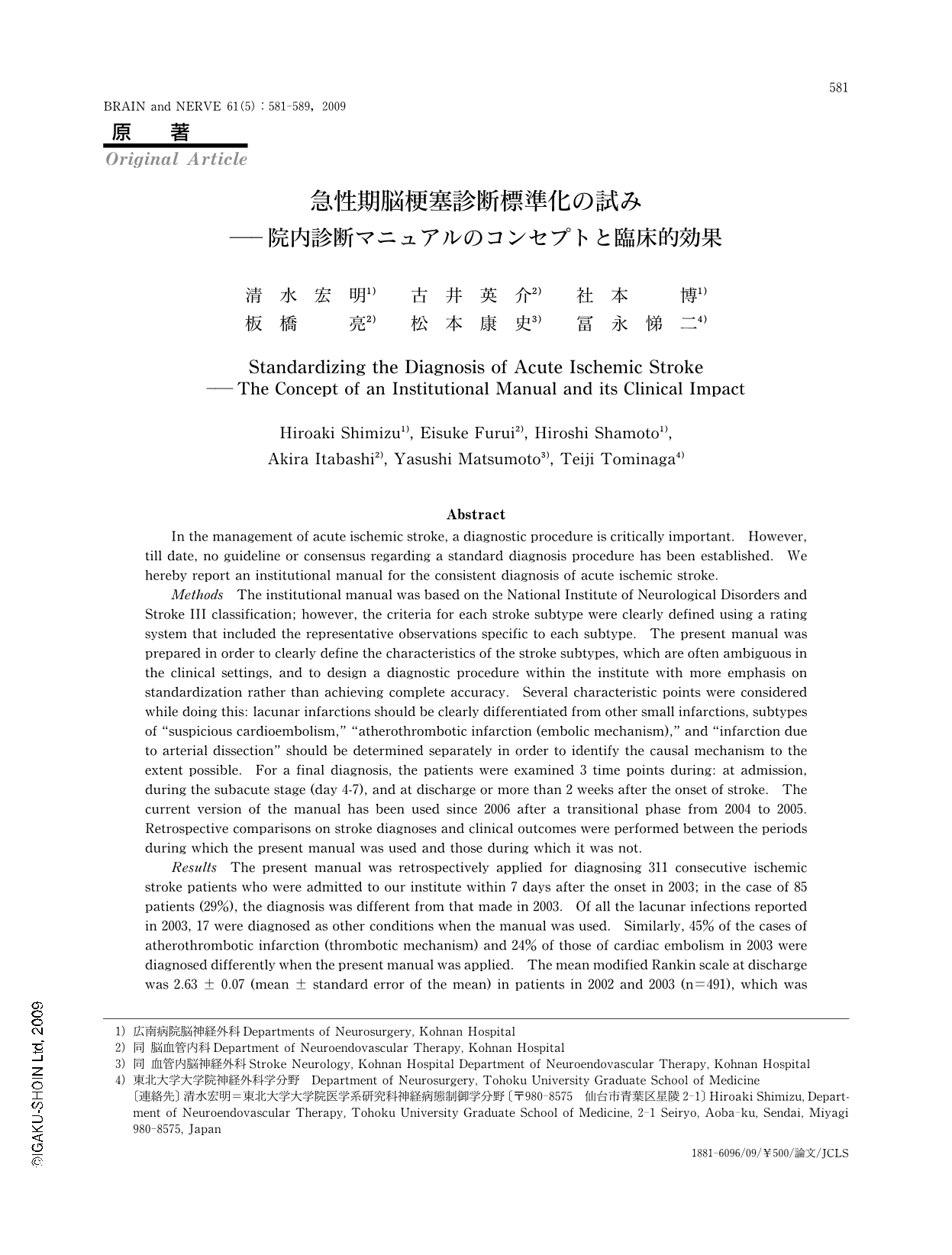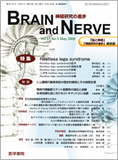Japanese
English
- 有料閲覧
- Abstract 文献概要
- 1ページ目 Look Inside
- 参考文献 Reference
はじめに
「脳卒中治療ガイドライン2004」1)により脳梗塞の標準となるべき治療が明確となった。個々の患者においては病態に応じた修飾が必要であるが,そのためにも柱となるガイドラインの存在は重要と考えられる。
一方,治療ガイドラインの有効活用には,正しい診断が前提となる。脳梗塞であるかどうかはもちろん,脳梗塞の病型診断を的確に行うことがガイドラインに沿った,病態に合致した治療を行うための第1の必要事項と考えられる。しかし,診断に関する教科書的な記載は多数あるものの急性期の病態に合わせたものや標準化されたものはなく,各医師(あるいは診療チーム)の判断に一任されているのが実情である。そのため実際の救急患者を前にして行われる診断は施設によるばらつきが大きい可能性があるうえ,施設内においてさえ必ずしも均質とは限らない2)。これらの問題点を少しでも解決するには施設内診断の標準化を文書で行うことが必要と思われる。
当院では,急性期脳梗塞の診断・治療に関する院内標準化を目指し,主に研修医をターゲットとした院内診断・治療マニュアルを2004年6月より試作し,2006年よりほぼ現在のversionを使用してきた。これらは医学的に正確な診断・治療法を一期的に追求したものではなく,あいまいさをできるだけ排除して院内での均一性を高めることを主目的としている。診断・治療の均一化は定期的な自己評価を可能とし,定期的改善を図ることが可能になると考えられる。今回,そのうち診断マニュアルのコンセプト,内容,および臨床的効果を報告する。
Abstract
In the management of acute ischemic stroke, a diagnostic procedure is critically important. However, till date, no guideline or consensus regarding a standard diagnosis procedure has been established. We hereby report an institutional manual for the consistent diagnosis of acute ischemic stroke.
Methods The institutional manual was based on the National Institute of Neurological Disorders and Stroke III classification; however, the criteria for each stroke subtype were clearly defined using a rating system that included the representative observations specific to each subtype. The present manual was prepared in order to clearly define the characteristics of the stroke subtypes, which are often ambiguous in the clinical settings, and to design a diagnostic procedure within the institute with more emphasis on standardization rather than achieving complete accuracy. Several characteristic points were considered while doing this: lacunar infarctions should be clearly differentiated from other small infarctions, subtypes of "suspicious cardioembolism," "atherothrombotic infarction (embolic mechanism)," and "infarction due to arterial dissection" should be determined separately in order to identify the causal mechanism to the extent possible. For a final diagnosis, the patients were examined 3 time points during: at admission, during the subacute stage (day 4-7), and at discharge or more than 2 weeks after the onset of stroke. The current version of the manual has been used since 2006 after a transitional phase from 2004 to 2005. Retrospective comparisons on stroke diagnoses and clinical outcomes were performed between the periods during which the present manual was used and those during which it was not.
Results The present manual was retrospectively applied for diagnosing 311 consecutive ischemic stroke patients who were admitted to our institute within 7 days after the onset in 2003; in the case of 85 patients (29%), the diagnosis was different from that made in 2003. Of all the lacunar infections reported in 2003, 17 were diagnosed as other conditions when the manual was used. Similarly, 45% of the cases of atherothrombotic infarction (thrombotic mechanism) and 24% of those of cardiac embolism in 2003 were diagnosed differently when the present manual was applied. The mean modified Rankin scale at discharge was 2.63 ± 0.07 (mean ± standard error of the mean) in patients in 2002 and 2003 (n=491), which was significantly different from 2.32 ± 0.06 in patients in 2006 through March of 2008 (n=903; p=0.01).
Conclusion The present manual appears to be helpful to improve the uniformity of the diagnoses and the clinical results. It may also assist residents and their mentors in the educational field. The manual will require periodical evaluation and version upgrade in order to maintain its efficacy.
(Received: December 28,2007,Accepted: October 30,2008)

Copyright © 2009, Igaku-Shoin Ltd. All rights reserved.


